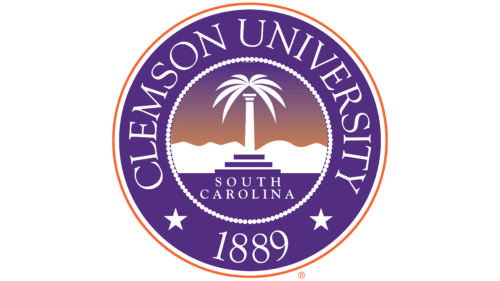The Clemson University logo contains only two words, but the inscription has a hidden meaning thanks to the thoughtful design. The designers deliberately enlarged the first line to draw attention and presented it in a bright orange color that evokes positive emotions. The lower level of the emblem looks like a pedestal because the word “University” is visually reinforced with horizontal lines.
Clemson University: Brand overview
| Founded: | 1889 |
| Headquarters: | Clemson, South Carolina, United States |
| Website: | clemson.edu |
Clemson University is engaged in research activities and allows students to study in seven areas, including applied, medical, social, and human sciences. It originated in 1889 and was originally called the Clemson Agricultural College of South Carolina. Many campus buildings were built by convicts, with some workers just 13 years old at the time. The university was named Clemson in 1964 when the government recognized its authority and broad capabilities. In 1896, the first football team appeared at the educational institution. She laid the foundation for the future Clemson Tigers sports arm.
Clemson University alumni include many successful business people, athletes, politicians, scientists, and television workers. They celebrate the university’s name and take it to the next level. As of 2021, this educational institution ranks 74th in the country’s ranking of the best national universities.
Meaning and History
All Clemson students know its corporate symbols: round stamp and logo. They represent the entire university (primarily the non-sports audience) but are used with restrictions. For example, the word mark is for non-commercial purposes only. It consists of a stylized uppercase lettering “CLEMSON” with a tiger paw print instead of an “O.” The graphic is called Tiger Paw and has existed since 1970. It was created based on a real print of a Bengal tiger’s paw.
The word “UNIVERSITY” is not included in the main logo. If used in alternative versions, it is placed at the bottom and written in reduced letters at large intervals so that the second line is the same length as the first. According to the branding guidelines, the color “UNIVERSITY” can be white, orange (branded Clemson Orange), or purple (Regalia).
What is Clemson University?
Clemson University is an American institution of higher education located in Clemson, South Carolina. It was opened in 1889 and was originally an agricultural college. Gradually, the number of directions grew to seven, covering the humanities, social, medical, and other sciences. Now it is a large university, with a ratio of teachers and students, which is 1:18.
Seal
The President’s Office must approve the use of the seal. It is placed on official certificates and must be supplemented with the registered trademark mark ®. This identity element is traditionally round. It contains a three-tiered pedestal and a column with palm leaves at the top. The undulating white stripe resembles the mountains that are visible on the horizon. It contrasts with a purple-orange gradient against a stylized palm tree background.
The name of the American state where the educational institution is located is written directly under the pedestal: “SOUTH CAROLINA.” The designers split it into two centered lines and used a sans-serif font.
The central part of the seal is outlined by a chain consisting of many small white circles placed in a wide purple ring. This ring, in turn, contains the inscription “CLEMSON UNIVERSITY” (in the upper half) and the number “1889” (below). Two five-pointed stars separate the year of the university’s foundation from its name. Two thin rings, white and orange, follow. They form the outer contour of the seal.
Clemson University: Interesting Facts
Clemson University, in Clemson, South Carolina, is a well-regarded public research university that has contributed to education, research, and public service since 1889. Founded by Thomas Green Clemson as a small agricultural college, it has evolved into a significant research hub.
- Military Roots: Initially a military school until 1955, Clemson still values its military heritage, offering a robust ROTC program and supporting military students and veterans.
- Land Grant Mission: As a land-grant university, Clemson is committed to education and research in agriculture, engineering, and more, aiming to serve the wider community.
- High-Level Research: Clemson is classified as an “R1: Doctoral University” for its very high research activity. It is at the forefront of discoveries in various disciplines.
- Founder’s Vision: The university was established through Thomas Green Clemson’s will, which donated his estate to South Carolina to found a scientific educational institution.
- Death Valley: Its football stadium, known as “Death Valley,” is famous for being one of the most daunting venues for visiting teams, partly due to its historical association with an old cemetery.
- Solid Orange Tradition: The “Solid Orange” tradition unifies the Clemson community, encouraging everyone to wear orange to support the university’s achievements.
- Clemson Ice Cream: Made on campus for over 100 years, Clemson Ice Cream is sold by the student-run ’55 Exchange, which offers students practical business experience.
- The Clemson Ring: A significant symbol of achievement and unity among students and alumni, receiving a Clemson Ring is a celebrated milestone.
- Automotive Research: The CU-ICAR campus highlights Clemson’s role in automotive research, showcasing its dedication to innovation and industry partnerships.
Clemson University stands out for its blend of historical tradition, academic excellence, and research contributions, significantly impacting locally and nationally. It remains dedicated to innovation and preparing students for the future, maintaining its position as a prestigious institution.
Font and Colors
The Tiger Paw graphic sign traditionally represents sports teams. It is also used for academic purposes: the designers have included it in the university logo, replacing the icon with the letter “O” in the word “CLEMSON.” This symbol can be recognized by its characteristic 10-degree slope and a small white stripe at the bottom formed at the scar’s site.
The wordmark and seal of the educational institution feature the Goudy Old Style font. It is distinguished by contrasting lines in width and elongated pointed serifs. All logos are united by one color – Clemson Orange (# F56600). It is complemented by purple Regalia (# 522D80), which makes the brand highly recognizable.
FAQ
What does the tiger paw mean in Clemson?
The tiger paw symbol used by Clemson University represents community, spirit, and excellence. The logo signifies shared uniqueness and collective pride among Clemson students, alumni, and supporters. It is a multifaceted symbol that unites the Clemson community, celebrates the university’s identity, and instills pride among its members.
Tiger paw meaning:
- Symbol of unity and family
- Determined spirit
- The pursuit of excellence
- Tradition and heritage
- Distinctive personality
- Cultural significance
- Symbolic links
What is Clemson’s motto?
Clemson University’s motto, “Who will tear us apart now?” demonstrates a strong sense of unity and connection within their community. It shows the strong connection between Clemson students, alumni, faculty, and staff. Clemson has a rich military heritage, and the motto reflects the solidarity and camaraderie inherent in military tradition. As a land-grant university, Clemson is committed to serving the community through education, research, and outreach. This motto is a source of pride for Clemson alumni and motivates students and alumni to maintain ties to the university, participate in its traditions, and contribute to its legacy.
What is Clemson University known for?
Clemson is one of the top public research universities in the country. Founded in 1889, it is intended to be a “seminary of excellence” focused on teaching, research, and service. Clemson offers more than 80 undergraduate majors and more than 110 graduate programs.
Clemson University is known for its strong academic programs, cutting-edge research, commitment to public service, and military heritage. Its selective admissions process, vibrant campus life, and excellent facilities contribute to its reputation as a leading public research university and forward-thinking institution.
What is Clemson University’s logo?
The university name is represented by two lines in the logo, each with different stylistic elements for clarity and appeal.
The top line features the serif “Clemson” to convey tradition, stability, and academic excellence. The bottom line says “University” in a sans-serif font that looks modern and clean. The word “Clemson” is in a bold orange font, symbolizing energy and enthusiasm. The word “University” is in purple, symbolizing dignity and pride. A horizontal stripe separates the two lines, emphasizing the structure of the logo.
The university seal, which accompanies the logo, features a palm tree in the center, symbolizing growth and sustainability. Around the palm tree is the name of the university and the year it was founded (1889). Combining fonts, colors, and design elements creates a logo that reflects the mission of honoring its past and moving forward with innovation.
What is the Clemson symbol?
Clemson’s tiger paw print is a powerful and iconic university symbol. It became part of the university’s logo, replacing the “O” in the word “Clemson,” helping to introduce the paw print as a university symbol. The design features bright, clean lines, usually in the university’s signature orange. The shape is simple yet effective, with four toe pads and a larger central pad miming a real tiger’s paw. This natural appearance links it to the university’s mascot, the tiger. It has grown into a widely recognized symbol representing Clemson’s heritage and traditions, serving as a unifying and inspiring symbol for students, alumni, faculty, and supporters.






